

Population Mountains. Subscribe to read. New London Model. New London Model toggle menu What's on Toggle Stay in touch Toggle.

From Olympic Park to East Bank: how St Paul's 'faux pas' led to design rethink. Trapped in a purgatory of masterplans, consultations and yet more plans, east London’s Queen Elizabeth Olympic Park is no stranger to revisions.
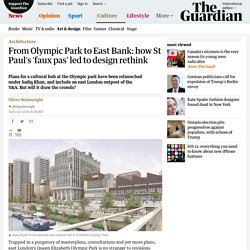
Proposals for a £1.3bn cultural hub, announced by former mayor Boris Johnson in 2013 and unveiled in 2016, have just been redesigned, rebranded and relaunched by the current mayor, Sadiq Khan, who, in a moment of deja vu, hailed it on Tuesday as “the most ambitious new project of its kind for decades”. Featuring an outpost of the Victoria and Albert Museum, a Sadler’s Wells dance theatre and a new home for the London College of Fashion, along with residential towers, the park’s planned arts district, once known as Olympicopolis, in tune with Johnson’s penchant for ancient Greek, has been reborn as East Bank, with the addition of a new base for the BBC symphony orchestra and recording studios.
Its architects say it is now a “more urban” place, a “piece of city” to line the edge of the park rather than a row of individual buildings. World to have 43 megacities by 2030 - UN. Building Heights in England from Emu Analytics. Explore urban open data. Cities from the sea: the true cost of reclaimed land. “Before, there were many fish,” says fisherman Mohd-Ishak Bin Abdul Rahman as he pulls a dried up crab from his net.

A few years ago he could just walk out into the surf and pick up crustaceans with his bare hands, he tells me. “Now, nothing.” He blames the palisade of new luxury condominiums that rise on the coastline behind him. Built on 240-acres of land artificially reclaimed from the sea, they are part of the Seri Tanjung Pinang 1 (STP1) project. These mega-projects will transform the world's greatest cities by 2030. Bjarke Ingels Groups' rendering of Europa City in Paris, France.BIG/Carlo Ratti The world is rapidly urbanizing.

The United Nations predicts that the number of people living in cities could double by 2050 — to 6.5 billion. London's skyline is set for a revamp with hundreds of skyscrapers planned over the next decade. London's skyline is poised for a facelift over the next decade as the capital's appetite for new skyscrapers strengthens, with more than 500 tall buildings currently in the pipeline.
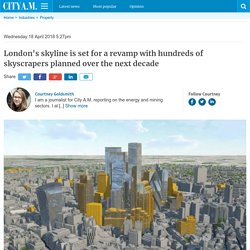
There are now 510 tall buildings – those over 20 storeys – ready for development, up from 455 in 2016, an annual survey by New London Architecture (NLA) and GL Hearn found. Canary Wharf and the Docklands continue to hold the highest number of tall buildings in the pipeline, with 70 towers planned in Greenwich and 85 in Tower Hamlets, both up from the previous year. The electric vehicle revolution will bring problems of its own. Opinion Updated After years of being derided as a joke by car manufacturers and the public, interest in electric vehicles has increased sharply as governments around the world move to ban petrol and diesel cars.
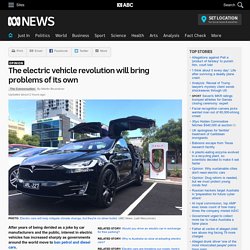
We have seen a tremendous rise in availability, especially at the premium end of the market, where Tesla is giving established brands a run for their money. Electric cars are likely to penetrate the rest of the market quickly too. The 100 million city: is 21st century urbanisation out of control? The 1960 street map of Lagos, Nigeria, shows a small western-style coastal city surrounded by a few semi-rural African villages.

Paved roads quickly turn to dirt, and fields to forest. There are few buildings over six floors high and not many cars. Story of cities #future: what will our growing megacities really look like? Amid the much-mythologised graffiti that appeared around Sorbonne University during the French civil unrest in May 1968, one line still stands out as intriguing and ambiguous: “The future will only contain what we put into it now.”
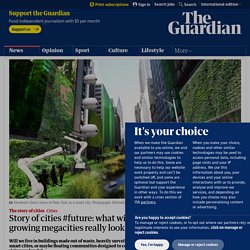
What appears at first utopian has more than a hint of the ominous. While augmented reality creates a city individualised for every occupant, and developments in modular architecture and nanotechnology might result in rooms that change form and function at a whim, the problem lies in the unforeseen. London installs pollution-absorbing 'bench' as effective as 275 trees. Green City Solutions, a German startup, has brought their innovative CityTree bench to London this March.

CityTree is a hi-tech wall and bench that has the pollution-fighting ability of 275 trees, while only taking up 1% of the actual space those many trees would need. It is seen as a functional solution to urban pollution in cities around the world. The CityTree was brought to London’s Glasshouse Street by The Crown Estate with the support of the Westminster City Council and cleantech company Evergen Systems, the exclusive UK supplier of CityTree. London Tubemap - A new angle on the London Underground. London air pollution live data – where will be first to break legal limits in 2018? On 30 January, Brixton Road in south London reached its annual legal limit for toxic nitrogen dioxide (NO2) – less than a month into the year.
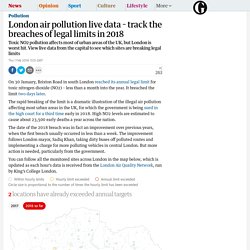
It breached the limit two days later. The rapid breaking of the limit is a dramatic illustration of the illegal air pollution affecting most urban areas in the UK, for which the government is being sued in the high court for a third time early in 2018. High NO2 levels are estimated to cause about 23,500 early deaths a year across the nation. The date of the 2018 breach was in fact an improvement over previous years, when the first breach usually occurred in less than a week. The improvement follows London mayor, Sadiq Khan, taking dirty buses off polluted routes and implementing a charge for more polluting vehicles in central London. Mapping the World's Wealthiest Cities. That’s about 11% of the world’s total private wealth The Chart of the Week is a weekly Visual Capitalist feature on Fridays.
Which cities are the world’s economic powerhouses, and what portion of global wealth is located in these key urban centers? Cities of the future may be built with locally available volcanic ash. MIT engineers working with scientists in Kuwait have found that volcanic rocks, when pulverized into a fine ash, can be used as a sustainable additive in concrete structures. In a paper published online in the Journal of Cleaner Production, the researchers report that, by replacing a certain percentage of traditional cement with volcanic ash, they can reduce a concrete structure’s “embodied energy,” or the total energy that goes into making concrete. According to their calculations, it takes 16 percent less energy to construct a pilot neighborhood with 26 concrete buildings made with 50 percent volcanic ash, compared with the energy it takes to make the same structures entirely of traditional Portland cement.
When they ground volcanic ash down to increasingly small particle sizes, the researchers found that a mixture of the finer powder and Portland cement produced stronger concrete structures, compared with those made from cement alone. Parag Khanna: How megacities are changing the map of the world. China's Shanghai sets population at 25 million to avoid ‘big city disease’
China’s financial hub of Shanghai will limit its population to 25 million people by 2035 as part of a quest to manage “big city disease”, authorities have said. The State Council said on its website late on Monday the goal to control the size of the city was part of Shanghai’s masterplan for 2017-2035, which the government body had approved. “By 2035, the resident population in Shanghai will be controlled at around 25 million and the total amount of land made available for construction will not exceed 3,200 square kilometres,” it said. Circles of Sustainability – Practical tools for creating sustainable cities and communities. This is Brixton: new video explores the impact of gentrification. After thirty years of Canary Wharf, how has it changed the geography of East London? CDRC Maps. These are the cities with the most sustainable transport. Sustainable mobility: Asian and European Cities lead the way. Hong Kong takes first place, followed by Zurich and Paris in the 2017 Sustainable Cities Mobility Index European cities lead on sustainable transport, making up seven of the top ten North American cities show opportunity for progress, not appearing in the top 20 Cities encouraged to see mobility as a strategic area of competitive advantage and make bold moves to improve quality of life Amsterdam, Netherlands, October 30, 2017 - Hong Kong leads the world for sustainable transport according to the 2017 Sustainable Cities Mobility Index from Arcadis, the leading global Design & Consultancy for natural and built assets.
European cities dominate the top of the overall Index, occupying seven of the leading ten spots. Cities benefiting from 'money, mass or maturity', namely high wealth, significant global cities, do not necessarily lead the ranking in sustainable urban mobility. How to Build a City That Doesn’t Flood? Turn it Into a Sponge. London has a novel solution for its housing crisis. Amsterdam won another prize from London, as financial companies in the British capital plan for life after the EU: Michael Spencer, CEO of NEX Group and a London financial grandee, said the company has chosen Amsterdam as its base on the continent. The hub provides a hedge for the company, should Brexit negotiators fail to secure a deal that shelters the UK’s financial sector.
The decision is focused on BrokerTec Europe, an electronic market for European government bonds. Spencer said on a conference call today that his firm could move about a dozen employees to Amsterdam to support the technology platform, depending the outcome of Brexit negotiations. The number of people involved understates the importance of those operations—€241 billion ($284 billion) of European repo, a vital form of short-term borrowing for banks, changed hands every day on the venue in October.
South Korea is building a $35 billion city designed to eliminate the need for cars. Milan is growing trees on skyscrapers. Kensington and Chelsea: a wealthy but deeply divided borough - Rich or rotten? This futuristic project uses mega-trees to power apartments. Why has London poverty become more spread out? The future is coming. Here's what it might look like. These maps show you just how divided US cities are - even on education. VICE - Climate change is only going to make gentrification... Green Vancouver.
Are we ready for the rise of megacities? South Africa’s wealth divide analyzed through impressive aerial photographs - Matador Network. The Incredible growth of megacities – GEOGRAPHY EDUCATION. Animated Map: The 20 Most Populous Cities in the World by 2100. Stratford redevelopment timelapse. Citymapper is launching its own bus service to fill transport gap in London. Haunting and Beautiful Before and After Pictures of Detroit. Economic Mobility and the Urban-Rural Divide - CityLab. Make Cities Explode in Size With These Interactive Maps.
Animated Map: The 20 Most Populous Cities in the World by 2100. Compare urban city data. This interactive map lets you watch who commutes to your city every day. From Jericho to Tokyo: the world's largest cities through history – mapped. America's geography of wealth: the shrinking urban middle class visualised. More than 100 Chinese cities now above 1 million people. Endless cities: will China's new urbanisation just mean more sprawl?
Burgess model or concentric zone model. Hoyt Model (Sector Model) of Urban Land Use 1939 by Homer Hoyt.